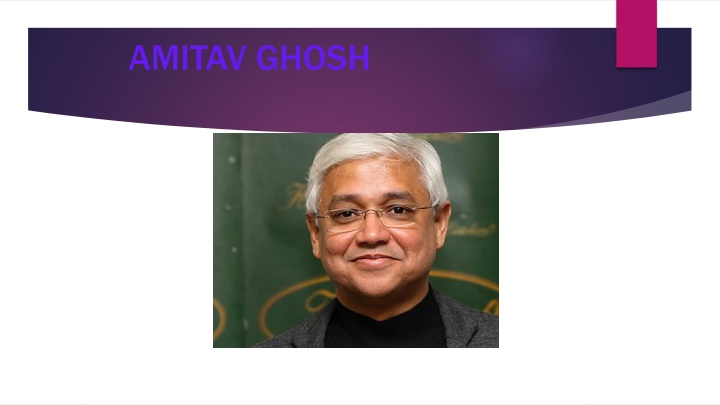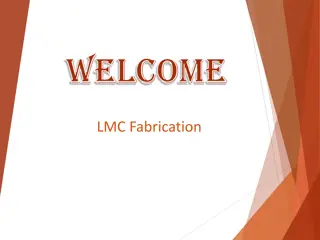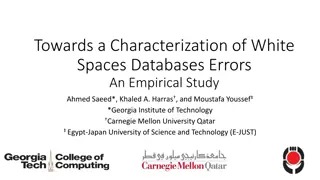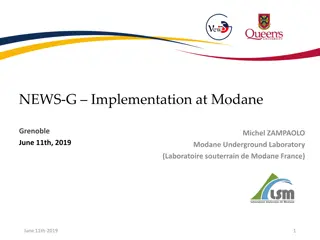Fabrication Processes for White Wares
Techniques like slip casting, plastic shaping, and pressing are used to shape ceramic components in their unfired state. Slip casting, the most common process, involves creating a clay-based suspension to produce hollow or solid ware. The formed pieces are dried and sintered to create products like sanitary ware, ceramic vases, and art objects.
Uploaded on Mar 20, 2025 | 1 Views
Download Presentation

Please find below an Image/Link to download the presentation.
The content on the website is provided AS IS for your information and personal use only. It may not be sold, licensed, or shared on other websites without obtaining consent from the author.If you encounter any issues during the download, it is possible that the publisher has removed the file from their server.
You are allowed to download the files provided on this website for personal or commercial use, subject to the condition that they are used lawfully. All files are the property of their respective owners.
The content on the website is provided AS IS for your information and personal use only. It may not be sold, licensed, or shared on other websites without obtaining consent from the author.
E N D
Presentation Transcript
Amitav Ghosh , One of the most prolific postcolonial writers writing today the winner of the 54thGyanpeeth award. Recipient of Sahitya Academy Award Padamshri Award
He is a social anthropologist by academic training. He has written extensively in both fiction and non-fiction sphere of literature. His works have been translated in more than 30 languages. He was awarded the Sahitya Akademi Award in 1990 for his book The Shadow Lines and the Padma Shri in 2007 for his services to literature and education.
Biographical Information Biographical Information Ghosh was born on July 11, 1956, in Calcutta, India, to Shailendra Chandra, a diplomat, and Ansali Ghosh, a homemaker. He traveled frequently in his youth, living in East Pakistan (now Bangladesh), Sri Lanka, Iran, and India. Ghosh attended Delhi University and received his B.A. with honors in history in 1976 and his M.A. in sociology in 1978. In 1978, he began studies at Oxford University in social anthropology. While at Oxford, Ghosh studied archives of documents from twelfth-century Egypt and was granted a scholarship that allowed him to travel to a small Egyptian village in 1980 to further his research. The village was located in the delta of the Nile River and Ghosh lived among the fellaheen, or Egyptian peasants. He graduated from Oxford earning a Ph.D. in social anthropology in 1982.
Ghosh has served as a visiting professor at several universities, including the University of Virginia, Columbia University, University of Pennsylvania, and American University in Cairo. Ghosh has also held the title of distinguished professor in the Department of Comparative Literature at Queens College, City University of New York, and has worked as a contributing writer to Indian Express, Granta, and New Republic.
The majority of Ghosh's writing focuses on exploring geographical and social boundaries. Amitav Ghosh s writing deals in the epic themes of travel and diaspora, history and memory, political struggle and communal violence, love and loss, while all the time crossing the generic boundaries between anthropology and art work.Both his fictional and non- fictional narratives tend to be transnational in sweep, moving restlessly across countries, continents and oceans.
His first novel, The Circle of Reason (1986), follows an Indian protagonist who, suspected of being a terrorist, leaves India for northern Africa and the Middle East . Blending elements of fable and picaresque fiction, it is distinctly postcolonial in its marginalization of Europe and postmodern in its nonlinear structure and thick intertextuality. The novel was inspired by Herman Melville's Moby-Dick.
In The Shadow Lines (1988), Ghosh juxtaposes the lives of two different yet intertwined families one Indian and one English to question the boundaries between their cultural and geographical settings. The title alludes to the blurring of the lines between nations and families, as well as the blurred lines within one's own self-identity. Ghosh depicts the characters of the novel as caught between two worlds, and the struggle to come to terms with both their present lives as well as their past forms the core of the narrative.. The Circle of Reason and The Shadow Lines, both written in English, were widely translated and gained Ghosh an international readership.
The Calcutta Chromosome: A Novel of Fevers, Delirium, and Discovery (1995) represented Ghosh s first foray into Science fiction. It is set in three different time periods late nineteenth century, 1995, and the near future and three different locales Calcutta, London, and New York. The mystery novel centers around the research for a cure for malaria. The narrative switches back and forth between time periods, revealing more and more clues to the puzzle
His subsequent novels included The Glass Palace (2000), a familial history centred on Burma (Myanmar) between its occupation by the British in 1885 through its independence after World War II and into the late 20th century, and The Hungry Tide (2004), set in Bengal and featuring American and Indian characters.
With Sea of Poppies (2009)a novel that describes individuals on the Ibis, a ship on the seas of Southeast Asia carrying coolies (indentured labourers) and opium Ghosh turned away from his earlier novels formal experimentation and toward a more traditional form of storytelling. Sea of Poppies was the first book in the Ibis trilogy, which takes place shortly before and during the first Opium war. The historical series also included River of Smoke (2011) and Flood of Fire (2015).
Drawing inspiration from a myth involving the snake goddess Manasa Devi, Ghosh wrote Gun Island (2019), about a rare-book dealer who undertakes a journey in which he must face issues of his past as well as climate change.
Ghosh also wrote In an Antique Land (1992), a book that straddles several genres travel writing, autobiography, memoir and blurs fiction and nonfiction. In it Ghosh described his experiences in a rural Egyptian village in the early 1980s, when he went there as an academic researcher, and in the late 1980s, when he returned there. His nonfiction works included Dancing in Cambodia, at Large in Burma (1998), The Imam and the Indian (2002), and Incendiary Circumstances: A Chronicle of the Turmoil of Our Times (2005).
CONCLUSION The Circle of Reason, The Shadow Lines, The Calcutta Chromosome, and The Glass Palace all received sharply mixed assessments from reviewers. Some critics argued that the narratives particularly in Ghosh's first two novels lacked unity and suffered from the presence of too many characters and distracting digressions.
Nevertheless, Ghosh has received overwhelmingly positive reviews for his arresting language and original prose style. Several critics have commented on the similarities between Ghosh's narrative style and traditional Indian and Arabic folk tales. Ghosh's work has also been favorably compared to the work of fellow Indian expatriate writer Salman Rushdie.
References ONLINE SOURCES





















